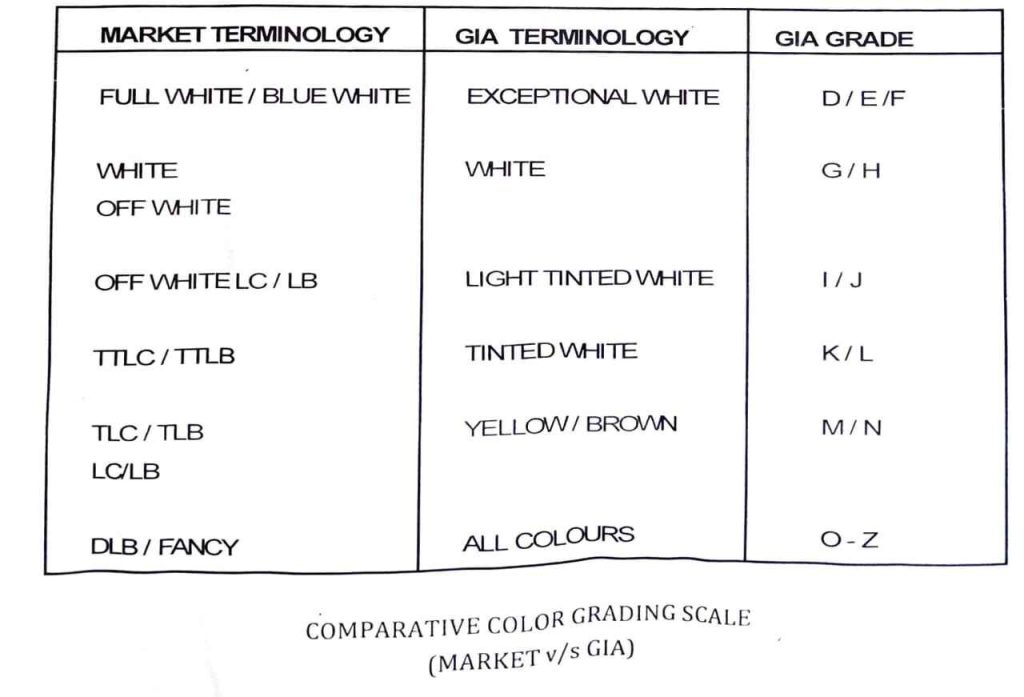Diamond colour grading is a subjective process and decision made at length is usually less reliable than those reached more quickly. This is because the eyes tires quickly and the ability to grade accurately diminishes.
Table of Contents
In the context of diamonds, “diamond color” refers to the presence or absence of color in a diamond. The Gemological Institute of America (GIA), one of the leading authorities on diamonds and gemstones, grades diamond color on a scale from D (colorless) to Z (light yellow or brown). The scale is designed to measure the subtle differences in diamond color.
- D, E, and F: These diamonds are considered colorless. They are very rare and allow the most light to pass through, creating a brilliant sparkle.
- G, H, I, and J: These diamonds are near colorless. They still appear colorless to the untrained eye, especially when mounted in jewelry, and are more affordable than colorless diamonds.
- K, L, and M: These diamonds have faint yellow or brown color. The color is more noticeable in larger diamonds.
- N to Z: These diamonds have noticeable color and are usually not preferred for engagement rings or other jewelry, although they can be used creatively in certain jewelry designs.
It’s important to note that diamond color can significantly impact a diamond’s value and appearance, especially in larger stones or those with higher levels of clarity and cut quality. When selecting a diamond, it’s essential to consider the balance between color, clarity, cut, and carat weight to find a stone that fits your preferences and budget.
different standards of diamond Color Grading
It is difficult to compare two diamonds of different sizes, different proportions, or different hues. Larger diamonds can be downgraded against the smaller stones of the same color because any slight trace of the color present is easier to see in, say, 1ct. stones in a 0.20ct. stone.

Diamonds with deep pavilion tend to look darker in color than well-proportion stones, even if both stones are precisely the same color. To solve this problem, it is necessary to compare like areas of each diamond, just above the girdle plane. Diamond fluorescence is an important aspect of color grading because a diamond fluoresces under different lighting conditions.
Here are the methods commonly used to assess diamond color:
Checking the color of a diamond typically requires a trained gemologist or specialized equipment.
- Comparison with Master Stones: Gemologists use a set of master stones, which are diamonds of known colors, to compare and determine the color grade of a diamond. By placing the diamond next to these master stones, they can identify the closest match and assign the appropriate color grade.
- White Background: Placing the diamond against a white background or jeweler’s tray can help reveal its true color. The absence of color becomes more apparent when viewed against a neutral white surface.
- Natural Daylight: Examining the diamond in natural daylight provides a good indication of its color. Daylight is balanced and can show the diamond’s true color without any artificial lighting effects.
- Color Grading Tools: Gemological tools like a colorimeter or spectrophotometer can measure the diamond’s color objectively. These devices emit specific wavelengths of light through the diamond and analyze the transmitted light to determine its color grade.
- Jeweler’s Loupe: Using a jeweler’s loupe (a small magnifying glass) with 10x magnification, a trained professional can inspect the diamond for any visible hints of color. Color nuances are often subtle and might not be visible to the naked eye.
- UV Light: Some diamonds fluoresce under ultraviolet (UV) light. Blue fluorescence can make a slightly yellow diamond appear whiter, but strong fluorescence may cause a diamond to appear milky or oily, affecting its overall color quality.
- Professional Gemological Laboratories: If you’re purchasing a diamond and want an accurate and detailed assessment of its color, it’s advisable to get a grading report from a reputable gemological laboratory such as the Gemological Institute of America (GIA) or the International Gemological Institute (IGI). These reports provide precise information about the diamond’s color grade along with other important characteristics.
When assessing a diamond’s color, it’s crucial to rely on the expertise of a certified gemologist or a reputable gemological laboratory to ensure accurate and reliable results.
if you wish to need know more details about international color diamond grading then please visit this article.
buy diamonds direct from manufacturers, please visit our online store,



